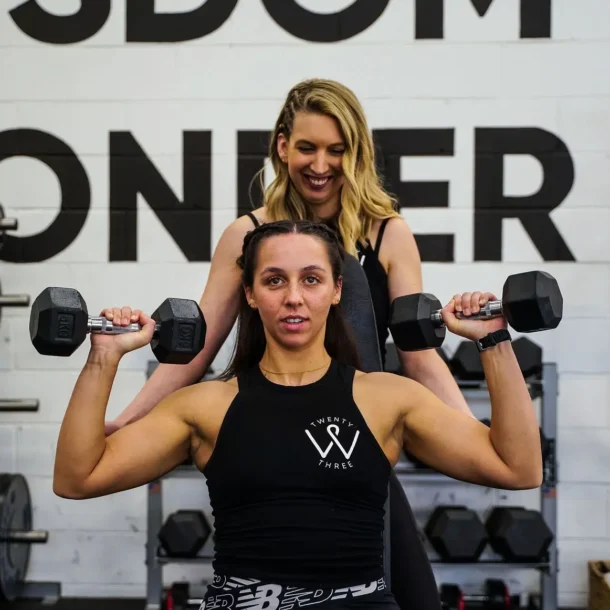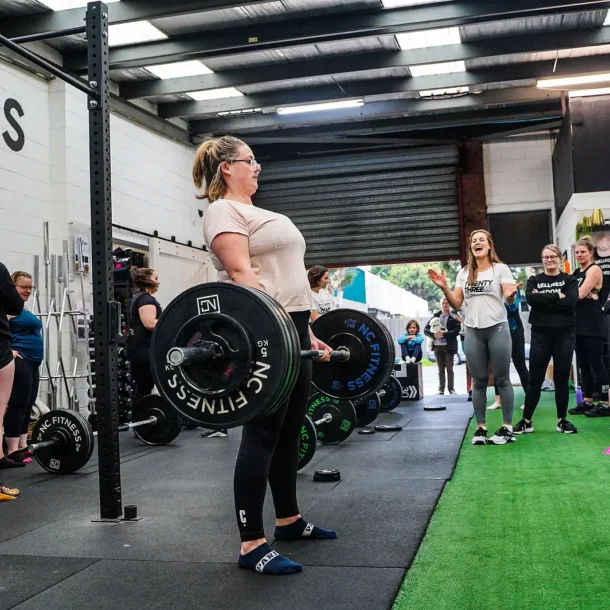
As women enter their 40s and 50s, their bodies undergo significant physiological changes due to menopause, which necessitates reevaluation of their training strategies.
It’s a conversation we have repeatedly with potential new members who feel lost in their current routine. Maybe you have noticed that your body feels different and what has workedfor you in the past is no longer working now?
This critical period involves a decline in estrogen and progesterone levels, which impact everything from muscle integrity to metabolic health. This blog post delves into why adapting training approaches for menopausal athletes and those in the perimenopausal transition is not just beneficial but essential.
Estrogen is pivotal in maintaining muscle quality. Estradiol (one specific type of estrogen) is a female’s main anabolic driver. It enhances mitochondrial function and reduces oxidative stress and inflammation. However, during menopause, estrogen levels drop, leading to increased body inflammation, decreased insulin sensitivity, mood alterations, and cognitive changes. Most notably, this transition contributes to a loss of lean muscle mass and an increase in fat gain.
The muscle’s ability to regenerate is compromised without sufficient estrogen, leading to weaker muscle contractions. This is because the sensitivity of estrogen receptors, which play a crucial role in muscle response to training, decreases.

Traditional training methods often fall short as they do not consider the altered hormonal landscape of menopausal women. When we talk about ‘traditional training’ methods we are referring styles of exercise that women have traditionally opted for. This includes group style bootcamps, longer form interval style workouts, Pilates, Yoga or running.
To counteract the effects of decreased estrogen, specific training modifications are recommended:
High-Intensity Interval Training (HIIT): This includes sprint interval training (SIT), which is particularly beneficial for improving metabolic control and body composition. HIIT promotes mitochondrial adaptations and antioxidation, helping to reduce oxidative stress while enhancing insulin sensitivity and cardiovascular health. It is important that this is actual High Intensity exercise, which means there is a short period of time where the heart rate increase rapidly and then sufficient time is given for it to return close to baseline.
Heavy Resistance Training: Engaging in low-repetition, heavy-weight training is crucial for stimulating muscles and bones. It compensates for the hormonal changes that affect muscle contraction and bone density, thereby maintaining strength and metabolic health. Ideally some of these sets should be in the 6 rep or less category.
Plyometrics and Power Training: Essential for sustaining strength, power, and neuromuscular activation, these exercises help compensate for the loss of muscle power due to hormonal changes.
Resistance training is particularly crucial for building strength and increasing the size of skeletal muscles during menopause. It helps in:
It’s important for menopausal athletes to incorporate strength training focused on both muscle force and hypertrophy to maintain muscle integrity and function.
Menopausal athletes might also face issues like pelvic floor weakness and joint pain. It’s advisable to engage with a pelvic floor specialist and include mobility work, warm-ups, and anti-inflammatory foods in their routine. Starting with proper movement patterns before progressing to heavier weights can help in adapting the body to new stressors without risk.
For women in their 40s and 50s, adjusting training methodologies to suit their physiological needs is not just about maintaining fitness but also enhancing overall health and quality of life. By integrating HIIT, heavy resistance training, and plyometrics into their routines, menopausal athletes can effectively mitigate the impacts of hormonal changes, ensuring they remain strong, healthy, and active throughout their menopausal years and beyond.
To optimise results, we recommend 2-4 strength training sessions and 1-2 HIIT or SIT sessions per week (no longer than 30 minutes).
This strategic approach not only maintains physical performance but also supports metabolic health, bone density, and muscular function during a pivotal time of change.







